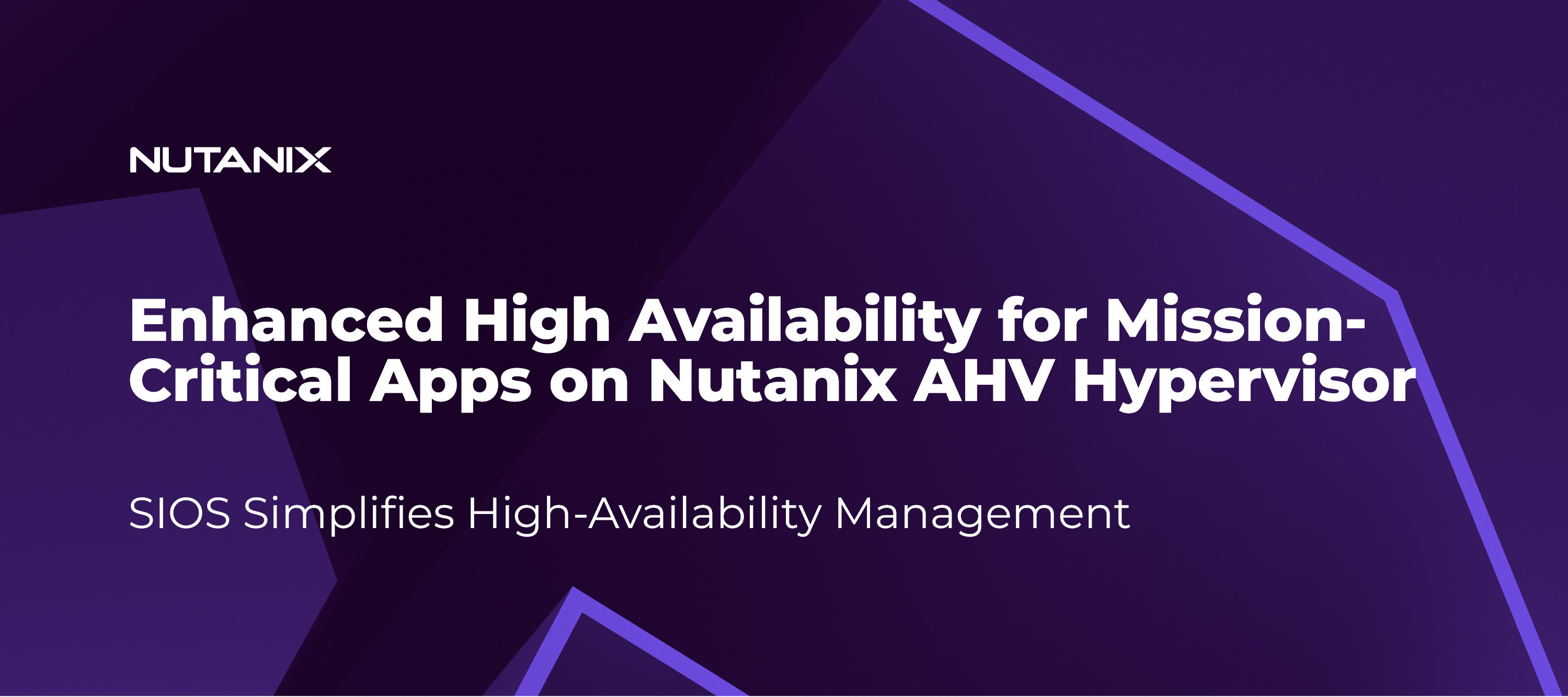With recent disruption in the virtualization market, more customers are switching to the Nutanix AHV hypervisor due to its benefits that simplify management, enable seamless scalability and enhance efficiency.
AHV provides robust built-in high-availability (HA) capabilities for VMs. However, extending HA to the application layer can be challenging for enterprises running business-critical applications across complex environments with mixed workloads, multiple datacenters and different operating systems.
SIOS can help whether you’re new to Nutanix AHV or an existing Nutanix customer considering options for bringing true HA capabilities to the application level. In this blog, we review how SIOS LifeKeeper® and DataKeeper® work to extend the benefits of AHV for HA and enable more resilient applications.
Built-In HA for Nutanix AHV Hypervisor
The Nutanix AOS architecture integrates automated HA for VMs to protect availability in the event of an application failure. If a failure occurs, VMs are restarted on healthy nodes throughout the AHV cluster.
For organizations that require added capabilities for application resilience, SIOS, a Nutanix Technology Alliancemember, offers customers a solution that mitigates the operational and financial impact of application failures.
For use cases like finance, health records and operational databases, SIOS can help reduce data loss, protect against disruptions and reduce risk for applications where minutes of downtime can mean thousands of dollars lost.
How SIOS Raises the Bar for Application Availability
SIOS provides streamlined HA solutions for mission-critical applications within Nutanix AHV environments. SIOS LifeKeeper and DataKeeper provide near flawless application-level availability for essential applications, databases and ERPs.
Five Ways SIOS Delivers Simplified HA Application Management for AHV
SIOS works with Nutanix to reduce risk, enhance resilience and support continuous availability – all while dramatically simplifying the complexity that comes with enterprise-scale HA management. Here are five important benefits of the SIOS and Nutanix HA solution.
Maximized Uptime with Failover Clustering
SIOS extends the built-in HA features of AHV through failover clustering, which calls for running critical applications on a primary node that is clustered with one or more secondary nodes. This cluster is synchronized to enable the automatic, seamless failover of applications and continuity if an issue arises.
This approach is the only way to provide near continuous availability for applications like SQL Server, S/4 HANA, PostgreSQL, and Oracle Enterprise, where a few minutes of unplanned downtime can result in costly operational disruptions and data loss.
In a Nutanix environment, customers can choose between shared storage setups where cluster nodes all connect to a SAN or a shared-nothing configuration where the primary node's local storage is synchronized with secondary nodes for efficient host-based, block-level replication.
Nutanix-Validated Clustering Software
Customers transitioning to Nutanix AHV might already have an existing HA solution, but not all clustering software is compatible with the Nutanix AOS architecture.
SIOS DataKeeper and SIOS LifeKeeper are validated as Nutanix-Ready to deliver dependable replication and cross-subnet failover for regional disaster recovery. SIOS LifeKeeper provides full monitoring of the entire application stack – network, storage, OS, and application – and ensures automatic failover when necessary.
Simplified HA Management Across Environments
Because SIOS clustering software supports leading Linux distributions in addition to Windows, it offers a streamlined solution that ensures HA while providing a consistent user experience for companies that run applications in multiple operating systems.
Compared to open-source solutions or OS-specific clustering solutions, SIOS limits complexity, eliminates manual scripting and configuration requirements, and provides cross-platform compatibility.
For example, a prototypical environment with SAP HANA running on Red Hat, a DB2 database running on SUSE, and SQL Server running on Windows would require three different failover clustering solutions, each with its own configuration and management interface. SIOS streamlines this to a single, unified clustering solution.
Safe Shared-Storage Clustering for Windows
SIOS DataKeeper supports SCSI reservations, which are critical when using shared storage for Windows clusters in a Nutanix hyperconverged infrastructure (HCI). These reservations allow multiple nodes to access a shared disk while preventing data corruption and ensuring smooth failover and failback orchestration.
Flexible Failover Options for Complex Environments
SIOS extends the flexibility that defines Nutanix environments to HA management and provides greater control by allowing for the configuration of failover at the operating system or application level.
Compared to hypervisor-level controls, this more granular control allows organizations to effectively manage failover across complex environments that extend across different workloads, hypervisors, and datacenters. Nutanix’s capability to track real-world workload data adds to this flexibility, enabling more informed and data-driven failover decisions.
Learn More About Application-Level HA
Combining Nutanix HCI with a robust clustering solution like SIOS LifeKeeper or DataKeeper keeps your mission-critical applications up and running, enhances organizational resilience, and mitigates risks to operational continuity and data integrity.
For a more in depth look at the benefits of SIOS validated solutions for Nutanix, explore this white paper on 10 Expert High-Availability Insights.
©2024 Nutanix, Inc. All rights reserved. Nutanix, the Nutanix logo and all Nutanix product and service names mentioned herein are registered trademarks or trademarks of Nutanix, Inc. in the United States and other countries. LifeKeeper and DataKeeper are registered trademarks of SIOS Technology Corp. in the United States and other countries. All other brand names mentioned herein are for identification purposes only and may be the trademarks of their respective holder(s).


